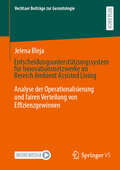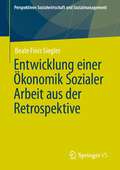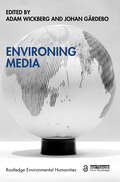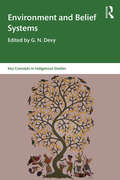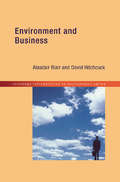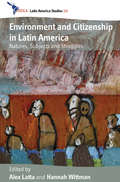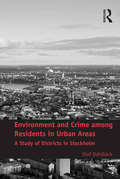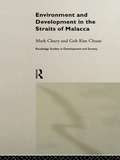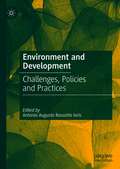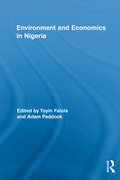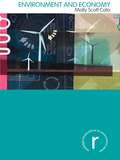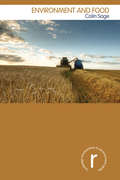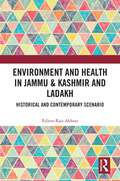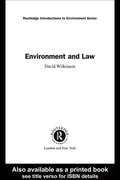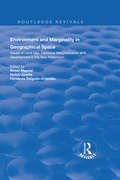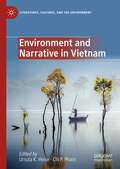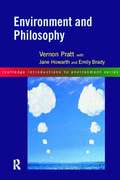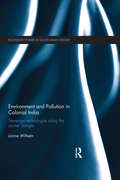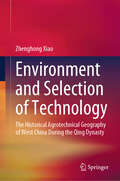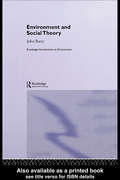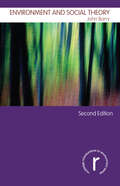- Table View
- List View
Entscheidungsunterstützungssystem für Innovationsnetzwerke im Bereich Ambient Assisted Living: Analyse der Operationalisierung und fairen Verteilung von Effizienzgewinnen (Vechtaer Beiträge zur Gerontologie)
by Jelena BlejaEine wesentliche Voraussetzung für das Zustandekommen und die langfristige Stabilität von Kooperationen zwischen Unternehmen ist, dass alle Beteiligten in angemessenem Umfang von der Zusammenarbeit profitieren und sich kein Unternehmen benachteiligt fühlt. Methoden der kooperativen Spieltheorie könnten in diesem Zusammenhang die Möglichkeit bieten, die kooperationsbedingten Vorteile zwischen den Beteiligten so zu verteilen, dass die Lösung von allen als fair bewertetet werden kann. Es ist jedoch schwierig, eine solche Lösung zu finden, und es bedarf einer vorherigen Operationalisierung des Verteilungsgegenstands. Es mangelt diesbezüglich sowohl an theoretischen Konzepten als auch an empirischen Erkenntnissen. An diesem Punkt setzt das vorliegende Buch an, indem ein Entwurf eines Entscheidungsunterstützungssystems zur Operationalisierung und fairen Verteilung von Effizienzgewinnen in Innovationsnetzwerken entwickelt wird. Hierfür werden sowohl Operationalisierungs- als auch Verteilungsansätze vorgestellt und analysiert. Abschließend werden anhand einer Fallstudie die Durchführung der Operationalisierung und Verteilung der Effizienzgewinne beispielhaft dargestellt sowie Modelleinschränkungen und -erweiterungen bezogen auf den AAL-Bereich diskutiert.
Entwicklung einer Ökonomik Sozialer Arbeit aus der Retrospektive (Perspektiven Sozialwirtschaft und Sozialmanagement)
by Beate Finis SieglerDer Band lässt 30 Jahre Beschäftigung der Autorin mit der Ökonomik Sozialer Arbeit Revue passieren, die in der Entwicklung eines alternativen Ökonomiemodells mündet. Mit dem Ansatz einer Autonomie fördernden Meritorik wird ein Analyserahmen für Soziale Arbeit vorgestellt, der Konsumentensouveränität neu interpretiert und mit einem ressourcenorientierten, auf Befähigung angelegten Ansatz in der Sozialen Arbeit kompatibel ist. Er ist zudem geeignet die Verflechtung von individueller Lebenslage, Sozialer Arbeit als personenbezogener sozialer Dienstleistung, Sozialmanagement, Sozialwirtschaft und Sozialpolitik bei der Erzeugung von Wohlfahrt angesichts knapper Ressourcen zu untersuchen. Wie viele Ressourcen sollen für was und wen mit welchem Ziel warum und wozu von wem wie zur Verfügung gestellt werden?
Entwicklung, humanitäre Hilfe und soziale Wohlfahrt: Sozialer Wandel von innen nach außen
by Cornelia C. WaltherIn diesem Buch wird untersucht, wie menschliches Verhalten durch unsere Wünsche, Emotionen, Gedanken und Empfindungen geformt wird und wie sich umgekehrt die Erfahrungen, die sich aus unserem Verhalten ergeben, auf uns selbst, andere und den Planeten auswirken. Auf der Grundlage einer Analyse des ständigen Wechselspiels zwischen diesen vier Ebenen bietet es praktische Lösungen, um systematisch eine nachhaltige gesellschaftliche Veränderungsdynamik in Gang zu setzen. Es wird aufgezeigt, warum der Wandel, zusätzlich zur wirtschaftlichen und politischen Transformation auf der Makroebene, mit einem Bewusstseinswandel auf der Mikroebene beginnt. Dabei stellt er die fehlende Verbindung zwischen Investitionen in die persönliche Befähigung und das kollektive Wohlergehen her. Ein neuartiges theoretisches Paradigma bildet die Grundlage dieses Buches, das in der Perspektive einer kontinuierlichen "Körper-Geist-Herz-Seele-Verbindung" verankert ist. Ausgehend von der Prämisse, dass eine gerechte Gesellschaft allen zugute kommt, wird argumentiert, dass Anstrengungen, die für andere unternommen werden, auf drei Ebenen Vorteile bringen - für den Einzelnen, der handelt, für denjenigen, für den gehandelt wurde, und für die Gesellschaft.
Entwicklungspolitik: Eine Einführung in Zielsetzungen und Ergebnisse
by Joachim BetzEntwicklungsländer haben seit den 1990er Jahren rasche, aber höchst unterschiedliche Fortschritte gemacht. So weit, dass sich die Grenzen zu den traditionellen Industrieländern teilweise verwischt haben. Andererseits gibt es eine Reihe von meist fragilen Staaten, denen das nicht oder nur ansatzweise gelungen ist. Die Rede von der einen „Dritten Welt“ und gemeinsamen Entwicklungsproblemen erklärt also nur noch wenig. Stattdessen ist Entwicklung eine Anforderung an alle Staaten geworden, die in diesem Lehrbuch nach den wesentlichen Entwicklungszielen aufgeschlüsselt und bewertet werden.
Enveloped Lives: Caring and Relating in Lithuanian Health Care
by Rima PraspaliauskieneHanding envelopes containing money or gifts to doctors in public health care is often seen as a remnant of socialism that continues as an integral part of the Lithuanian health care system. Rima Praspaliauskiene uses the envelope to explore complex doctor-patient interactions that go beyond notions of the gift or the bribe. She reshapes our definition of corruption and encourages seeing these practices as emerging forms of care that impede the neoliberal health care reforms effected in the post-Soviet era. Enveloped Lives extends the analytical categories of gift, care, money, and transparency, shifting attention away from material transactions by prioritizing relations and practices that transcend economic rationality. At a time when health care reforms and the costs of care are being widely debated, this book is a contribution to the larger discussion about the ethics and future of health care around the world.
Environing Media (ISSN)
by Adam Wickberg Johan GärdeboThis edited volume interrogates the role of media technologies in the formation of environments, understood both as physical spaces and as epistemological constructs about them. Using the concept of ‘environing media’, the book advances a deeper understanding of how media processes – defined here as the storage, process, and transmission of data – influence human-Earth relations.Virtually all aspects of the interconnected global ecological crisis can be related to the intensification and acceleration of scaling up the human imprint on the planet by technological means. Combining ideas from the humanities, arts, and humanistic social sciences, Environing Media offers a perspective on how we entered the current geological epoch – the Anthropocene. The ten chapters explore colonial, planetary, and elemental environing media, with cases including indigenous history, ocean monitoring, computational history, climate modeling, environmental history, the air as medium, the biosphere, and the Earth system.Drawing upon a breadth of examples and expertise in history, anthropology, geography, cultural history, science and technology studies, and media studies, the book discovers a novel approach to human-Earth histories that demonstrates how technologies have mediated between humans and environments and in the process contributed to a societal feedback loop between knowing and doing environment, each impacting the other. Environing Media is a timely addition for scholars and upper-level students in environmental humanities and media studies.The Open Access version of chapters 1, 2, 3, 4, 5, 7, 8, and 9 are available at http://www.taylorfrancis.com/books/e/9781003282891. Chapters 1, 2, 4, 5, and 7 have been made available under a Creative Commons Attribution-Non Commercial-No Derivatives 4.0 (CC BY-NC-ND 4.0) license. Chapters 3, 8, and 9 have been made available under a Creative Commons Attribution (CC-BY 4.0) license.
Environing Media (Routledge Environmental Humanities)
by Adam Wickberg Johan GärdeboThis edited volume interrogates the role of media technologies in the formation of environments, understood both as physical spaces and as epistemological constructs about them. Using the concept of ‘environing media’, the book advances a deeper understanding of how media processes – defined here as the storage, process, and transmission of data – influence human-Earth relations. Virtually all aspects of the interconnected global ecological crisis can be related to the intensification and acceleration of scaling up the human imprint on the planet by technological means. Combining ideas from the humanities, arts, and humanistic social sciences, Environing Media offers a perspective on how we entered the current geological epoch – the Anthropocene. The ten chapters explore colonial, planetary, and elemental environing media, with cases including indigenous history, ocean monitoring, computational history, climate modeling, environmental history, the air as medium, the biosphere, and the Earth system. Drawing upon a breadth of examples and expertise in history, anthropology, geography, cultural history, science and technology studies, and media studies, the book discovers a novel approach to human-Earth histories that demonstrates how technologies have mediated between humans and environments and in the process contributed to a societal feedback loop between knowing and doing environment, each impacting the other. Environing Media is a timely addition for scholars and upper-level students in environmental humanities and media studies.
Environment and Belief Systems (Key Concepts in Indigenous Studies)
by G. N. DevyPart of the series Key Concepts in Indigenous Studies, this book focuses on the concepts that recur in any discussion of nature, culture and society among the indigenous. The book, the first in a five-volume series, deals with the two crucial concepts of environment and belief systems of indigenous peoples from all the continents of the world. With contributions from renowned scholars, activists and experts from around the globe, it presents a salient picture of the environments of indigenous peoples and discusses the essential features of their belief systems. It explores indigenous perspectives related to religion, ritual and cultural practice, art and design, and natural resources, as well as climate change impacts among such communities in Latin and North America, Oceania (Australia, New Zealand and the South Pacific Islands), India, Brazil, Southeast Asia and Africa. Bringing together academic insights and experiences from the ground, this unique book's wide coverage will serve as a comprehensive guide for students, teachers and scholars of indigenous studies. It will be essential reading for those in anthropology, social anthropology, sociology and social exclusion studies, religion and theology, and cultural studies, as well as activists working with indigenous communities.
Environment and Business (Routledge Introductions to Environment: Environment and Society Texts)
by David Hitchcock Alasdair BlairThis text examines how businesses and the environment interact. It is ideal for students with no previous knowledge of business studies. It examines in depth the ways in which business, industry, the physical environment, environmentalism and social change have evolved alongside each other. The authors use boxed case-studies to highlight how business practice and the environment interact at levels from local to global, with examples from multinational companies, government bodies, national charities and local enterprise. The book also contains a large number of informative diagrams. The case studies include: * Shell Oil's environmental policy* railways and the industrial revolution* the British National Trust's business enterprises* Sainsbury's approach to organic foods* Australia's landcare scheme* changing trends in retailing* Brent Spar * big game hunting and conservation.
Environment and Citizenship in Latin America
by Alex Latta Hannah WittmanScholarship related to environmental questions in Latin America has only recently begun to coalesce around citizenship as both an empirical site of inquiry and an analytical frame of reference. This has led to a series of new insights and perspectives, but few efforts have been made to bring these various approaches into a sustained conversation across different social, temporal and geographic contexts. This volume is the result of a collaborative endeavour to advance debates on environmental citizenship, while simultaneously and systematically addressing broader theoretical and methodological questions related to the particularities of studying environment and citizenship in Latin America. Providing a window onto leading scholarship in the field, the book also sets an ambitious agenda to spark further research.
Environment and Crime among Residents in Urban Areas: A Study of Districts in Stockholm
by Olof DahlbäckThis groundbreaking book by Olof Dahlbäck analyzes the direct effects of the environment and the indirect effects of geographical differentiation of individuals on the offender rates of different urban areas. In order to do this, relationships between crime and independent factors are analyzed in various ways - by considering cross-sectional and longitudinal aspects, linear and non-linear models, point and change data, different time periods, micro- and macro-level interaction, and data for individuals with different patterns of moves. The offender rates analyzed refer to individuals suspected by the police. The directly crime-influencing processes focused upon imply that individuals are affected by social control and social resources. The study makes use of advanced analytical models, novel methods and comprehensive data, and it solves several problems that have hampered research.
Environment and Development in the Straits of Malacca (Routledge Studies in Development and Society)
by Mark Cleary Goh Kim ChuanThis unique study is the first in depth examination of the environment and development of the Straits. Taking an integrative approach, the book argues that the region has an underlying unity which political divisions (between Malaysia, Indonesia and Singapore) disguise. Its emphasis is on three major elements: first, a study of the historical geography of the region illustrates its role as a sea-corridor which connected the markets of India and China. Secondly, that contemporary patterns of economic development and trade have continued to increase the strategic importance of the region. Finally, the text highlights the major environmental problems, such as pollution, traffic and tourism, that now threaten the sea and coastline.
Environment and Development: Challenges, Policies and Practices
by Antonio Augusto Rossotto IorisThis book provides a comprehensive overview of emerging challenges facing different social groups, policy-makers and the international community related to economic growth, social development and environmental change, social inclusion and regional development. The book undertakes a critical assessment of the tensions associated with the failures of mainstream regulatory approaches and impacts of social and economic policies whilst widening the discussion on the interface between the expansion of the socio-environmental demands, equity and justice. These are crucial challenges, of great importance today and of equal relevance to the Global North and South. The book explores one of the main contradictions of development, the simplification of assessments and narrow consideration of alternatives. Taking this dilemma as its departure point, it goes on to examine the justification, trends and limitations of Western-based development and possible alternatives to fundamentally modify the basis and the rationale of the development process. It considers theoretical and lived experiences of development, paying attention to multiple scales, local realities and economic frontiers. Contributing authors explore policy recommendations and discuss effective practical tools for determining the values different people hold for ecosystem services and territorial resources. They cover the monitoring of change in the provision of ecosystem services that might increase the well-being of vulnerable groups as well as strategies to promote innovation and integrated, equitable and sustainable development.
Environment and Economics in Nigeria (Routledge African Studies)
by Toyin Falola Adam PaddockThis volume gathers contributors across a wide range of disciplines to explore the relationship between the environment, economics, and development in Nigeria from the twentieth century to the present, examining issues such as violence, health, and contemporary concerns about sustainability and conservation. It sheds light not just on the environmental history of Nigeria - a crucial, paradigmatic case in its own right - but also offers insights into these issues as they manifest themselves throughout the developing world.
Environment and Economy
by Molly Scott CatoAs environmental issues move to the centre of the political debate, more attention is being focused on the role our economy has played in creating the ecological crisis, and what a sustainable economy might look like. In spite of the success of the environmental movement in drawing attention to the crisis facing us, there has been comparatively little attention focused on the way the operation of the global economy contributes to this crisis. Environment and Economy provides a stimulating introductory insight into the history of thinking that has linked the economy and the environment. It begins by introducing readers to the pioneers of this field, such as Fritz Schumacher and Paul Ehrlich, who first drew attention to the disastrous consequences for our environment of our ever-expanding economy. Part two of the book describes the main academic responses to the need to resolve the tension between economy and environment: environmental economics, ecological economics, green economics, and anti-capitalist economics. Part three is structured around key themes including an introduction to economic instruments such as taxes and regulation; pollution and resource depletion; growth; globalization vs. localization and climate change. Each key issue is approached from a range of different perspectives, and working policies are presented in detail. Written in an accessible style, this introductory text offers students with an engaging account of the way that the various traditions of economic thought have approached the environment, bringing them together for the first time in one volume. The text is complimented by boxes, case studies and recommended reading for each theme addressed. It will be of value to students interested in environmental sciences, geography, green issues and economics.
Environment and Food (Routledge Introductions to Environment: Environment and Society Texts)
by Colin SageThis timely book provides a thorough introduction to the inter-relationship of food and the environment. Its primary purpose is to bring to our attention the multiplicity of linkages and interconnections between what we eat and how this impacts on the earth’s resources. Having a better idea of the consequences of our food choices might encourage us to develop more sustainable practices of production and consumption in the decades ahead. Although human societies have, over time, brought under control a large proportion of the earth’s resources for the purpose of food production, we remain subject to the effective functioning of global ecosystem services. The author highlights the vital importance of these services and explains why we should be concerned about the depletion of freshwater resources, soil fertility decline and loss of biological diversity. The book also tackles some of the enormous challenges of our era: climate change – to which the agri-food system is both a major contributor and a vulnerable sector – and the prospect of significantly higher energy prices, arising from the peaking of oil and gas supplies which will reveal how dependent the food system has become upon cheap fossil fuels. Such challenges are likely to have significant implications for the long-term functioning of global supply chains and raise profound questions regarding the nutritional security of the world’s population. Taken together the book argues that a re-examination of the assumptions and practices underpinning the contemporary food system is urgently required. Environment and Food is a highly original, inter-disciplinary and accessible text that will be of interest to students and the wider public genuinely interested in and concerned by the state of the world’s food provisioning system. It is richly illustrated with figures and makes extensive use of boxes to highlight relevant examples.
Environment and Health in Jammu & Kashmir and Ladakh: Historical and Contemporary Scenario
by Editor-Rais AkhtarThis engaging book presents an insightful look into the contributing factors that have shaped the modern public health system in Jammu & Kashmir and Ladakh. Reflecting on the historical, socio-economic, and contemporary scenario of environment and public health, this book presents chapters that discuss the role of spatial patterns of diseases, health-risk patterns, contributions of medical missionaries in health services in Kashmir, changing disease ecology of Leh, and traditional medical therapy in Ladakh, among others. This book also examines the cholera ecology in Kashmir during the 19th century, and the significance of Kangri ・ a portable traditional heat source ・ in cultural studies, economics, and cancer research. It investigates the role of traditional knowledge in the medical therapy of rural areas of Ladakh and the impact of urbanization on the quality of human health in Srinagar City. Besides, this book examines iodine deficiency disorders and the extension of vector-borne diseases. The essays also probe into the rising mental health concerns in post-pandemic Kashmir. This book will be useful for students, researchers, and teachers of physical geography, human geography, environmental studies, public health, and health sciences. It will also be of interest to political geographers, sociologists, policymakers, and those interested in the issues related to health and environment in the region.
Environment and Law (Routledge Introductions to Environment: Environment and Society Texts)
by David WilkinsonThis textbook provides a concise introduction for students with little or no legal background, to the role of law in environmental protection. It describes and explains law and legal systems, the concept of the environment, sources of environmental law and some of the techniques used in environmental law. Interdisciplinary in approach, the book explores some of the major connections between law and the disciplines of ethics, science, economics and politics.Environment and Law offers a greater understanding of international and national environmental law and has case-studies from all over the world, including examples from UK, US and Australian law.
Environment and Marginality in Geographical Space: Issues of Land Use, Territorial Marginalization and Development at the Dawn of New Millennium (Routledge Revivals)
by Heikki Jussila Fernanda Delgado-Cravidao Majoral RoserThis title was first published in 2000. An examination of environment and marginality in geographical space. It discusses the issue of marginalization from the point of view of the environment by using the viewpoints of land use, landscape and development. The aim of the book is to provide an overview of the issues at hand, while keeping a close connection with practical real-world examples of what, where and how environmental issues manifest on marginal areas. The book is divided into four main parts, which address: land use and environment; territorial marginalization; development in margins and peripheries; and summary and conclusions.
Environment and Narrative in Vietnam (Literatures, Cultures, and the Environment)
by Ursula K. Heise Chi P. PhamEnvironment and Narrative in Vietnam brings together essays about Vietnam’s natural environments and environmental crises from the perspective of culture, with particular attention to narrative templates that have shaped perceptions and interactions with nature on the part of different communities. The essays in this volume explore theoretical problems in the assessment of ecological stewardship and attitudes toward nature across cultures. They focus on both majority (Kinh) and ethnic minority narratives about nature and seek to outline how different ideas of modernization, from the French colonial project to the Marxist understanding of nature on the part of the Communist government, have shaped perceptions, policies, and activism regarding the environment. The essays also highlight the tensions and confluences between nationalist nation-building projects and economic integration into global markets for environmental thinking over the last half-century, and they analyze how texts from literary fiction to contemporary news media represent different environmental cultures in Vietnam. Taken together, the essays in Environment and Narrative in Vietnam begin to fill a significant gap in the understanding of environmental cultures in Asia and in the Environmental Humanities. This is an open access book.
Environment and Philosophy (Routledge Introductions to Environment: Environment and Society Texts)
by Emily Brady With Jane Howarth Vernon PrattEnvironment and Philosophy provides an accessible introduction to the radical challenges that environmentalism poses to concepts that have become almost second nature in the modern world. These include:* the ideas of science and objectivity* the conventional placement of the human being within the environment* the individualism of convential Modern thoughtWritten in an accessible way for those without a background in philosophy, this text examines ways of thinking about ourselves, nature and our relationship with nature. It offers an introduction to the phenomenological perspective on environmental issues, and also to the questions of what natural beauty is.
Environment and Pollution in Colonial India: Sewerage Technologies along the Sacred Ganges (Routledge Studies in South Asian History)
by Janine WilhelmIndia is facing a river pollution crisis today. The origins of this crisis are commonly traced back to post-Independence economic development and urbanisation. This book, in contrast, shows that some important early roots of India’s river pollution problem, and in particular the pollution of the Ganges, lie with British colonial policies on wastewater disposal during the late 19th and early 20th centuries. Analysing the two cornerstones of colonial river pollution history during the late 19th and early 20th centuries – the introduction of sewerage systems and the introduction of biological sewage treatment technologies in cities along the Ganges – the author examines different controversies around the proposed and actual discharge of untreated/treated sewage into the Ganges, which involved officials on different administrative levels as well as the Indian public. The analysis shows that the colonial state essentially ignored the problematic aspects of sewage disposal into rivers, which were clearly evident from European experience. Guided by colonial ideology and fiscal policy, colonial officials supported the introduction of the cheapest available sewerage technologies, which were technologies causing extensive pollution. Thus, policies on sewage disposal into the Ganges and other Indian rivers took on a definite shape around the turn of the 20th century, and acquired certain enduring features that were to exert great negative influence on the future development of river pollution in India. A well-researched study on colonial river pollution history, this book presents an innovative contribution to South Asian environmental history. It is of interest to scholars working on colonial, South Asian and environmental history, and the colonial history of public health, science and technology.
Environment and Selection of Technology: The Historical Agrotechnical Geography of West China During the Qing Dynasty
by Zhenghong XiaoThis book makes an insightful investigation of historical agrotechnical geography in West China in the Qing Dynasty from the perspective of historical geography and the history of agricultural technology. This study first divides West China into four regions, i.e., the Loess Plateau, Northwest China except the Loess Plateau, the Qinghai-Tibet Plateau, and Southwest China. Based on a systematic analysis of the geographical factors, such as heat, moisture, topography, soil, this study discusses the distribution and differentiation of the major technology types in these regions, ranging from the most primitive shifting cultivation and extensive cultivation to the most intensive cultivation, which are manifested in the crop structure and distribution, planting technology, water conservancy, tools, etc., as well as various combinations of these technologies. The diverse types and forms of technology and their specific combinations in different geographical spaces are mainly determined bythe diverse environmental conditions, which embodies the multi-factor correlation between technology mode and geographical environment and the internal unity of regional agricultural technology mode. In addition to the relationship between agricultural technology and geographical factors, it also takes social-economic, religious, and other cultural factors as important parameters, which were unique in West China, and significantly influence the trend of agrotechnological development. Through this study, it constructs the basic theoretical framework of historical agrotechnical geography and enlarges the scope of historical geography studies. And, since the author chose West China in the Qing Dynasty as the research subject, which was characterized by significant diversity and complexity in terms of natural geographical factors and socio-economic circumstances like religion and customs, this study provides a typical case for in-depth understanding of West China, so it is still of great academic value and important practical significance for the development of West China today.
Environment and Social Theory
by John BarryWritten in an accessible and jargon-free way, Environment and Social Theory examines: * the historical relationship between social theory and the environment *pre-Enlightenment and Enlightenment social theory and the environment * twentieth century social theory and the environment * economic theory and the environment * the relationship between ecology, biology and social theory * recent theoretical approaches to the environment * the development of a green social theory The ideas and vies of key theorists including Hobbes, Locke, freud, Habermas, Giddens and Beck are discussed to provide comprehensive coverage of social theory for non-specialist readers.
Environment and Social Theory (Routledge Introductions to Environment: Environment and Society Texts)
by John BarryWritten in an engaging and accessible manner by one of the leading scholars in his field, Environment and Social Theory, completed revised and updated with two new chapters, is an indispensable guide to the way in which the environment and social theory relate to one another. This popular text outlines the complex interlinking of the environment, nature and social theory from ancient and pre-modern thinking to contemporary social theorizing. John Barry: examines the ways major religions such as Judaeo-Christianity have and continue to conceptualize the environment analyzes the way the non-human environment features in Western thinking from Marx and Darwin, to Freud and Horkheimer explores the relationship between gender and the environment, postmodernism and risk society schools of thought, and the contemporary ideology of orthodox economic thinking in social theorising about the environment. How humans value, use and think about the environment, is an increasingly central and important aspect of recent social theory. It has become clear that the present generation is faced with a series of unique environmental dilemmas, largely unprecedented in human history. With summary points, illustrative examples, glossary and further reading sections this invaluable resource will benefit anyone with an interest in environmentalism, politics, sociology, geography, development studies and environmental and ecological economics.
